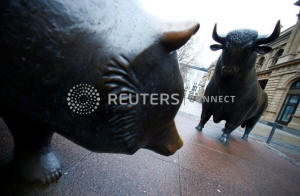Buy, sell, repeat! No room for 'hold' in whipsawing markets
 Send a link to a friend
Send a link to a friend
 [August 03, 2020]
By Saikat Chatterjee and Thyagaraju Adinarayan [August 03, 2020]
By Saikat Chatterjee and Thyagaraju Adinarayan
LONDON (Reuters) - Warren Buffett's
favourite holding period -- forever -- has few fans these days, with the
average length of time shares spend in a portfolio hitting record lows
this year as investors surf wild market swings for quick gains.
The length of time that investors hold shares has been shrinking for
decades but the trend accelerated this year in volatile markets that
have made people nervous about sitting on investments for too long.
There are different ways of slicing it, but Reuters calculations based
on New York stock exchange data show the average holding period for U.S.
shares was 5-1/2 months in June, versus 8-1/2 months at end-2019.
The previous record low of six months was hit just after the 2008
crisis. In 1999, for example, 14 months was the average.
Europe displays a similar trend, with holding periods shrinking to less
than 5 months, from 7 months last December.
Rob Almeida, a portfolio manager at asset manager MFS, said for years
mom-and-pop punters, commission-free investing and more machine-trading
have contributed to the trend.

But 0% interest rates, trillions of dollars of central bank and
government stimulus and high levels of uncertainty caused by the
pandemic have added to the momentum.
"Capital doesn't have a price thanks to all this stimulus," Almeida
said, "The COVID-19 crisis has accelerated the trend of short-termism in
investing."
Meanwhile there's little clarity on companies' future earnings, the
economic outlook and the pandemic outcome.
"So what's happening is this ability to act or trade or churn, whatever
you want to call it, based on information that may not be material,"
Almeida said.
Turnover ratios, the percentage of portfolio holdings that are replaced
in a 12-month period, increased to 92% at end-June, from 85% a year ago
for a group of global multi-asset funds tracked by Lipper.
The trend has ensured rich returns for nimble traders but also poses
questions about market stability once stimulus fades.
'BACK TO FRONT'
Market short-termism was highlighted as far back as 2010 by Bank of
England chief economist Andrew Haldane who described it as "subconscious
myopia."
But buy-and-hold investors have had a rough year so far. Stocks fell 40%
and bounced by the same margin in the space of three months. Around the
2008 crisis, moves of such magnitude occurred over three years.
[to top of second column]
|

Bull and bear statues are pictured outside Frankfurt's stock
exchange in Frankfurt, Germany, December 17, 2015. REUTERS/Ralph
Orlowski/File Photo

Kevin Russell, CIO of UBS' O'Connor hedge fund, with $6.1 billion in
assets under management, said his lowest turnover strategies, unable
to quickly adjust hedges and exposures, are now his worst
performing.
Low-turnover strategies struggle in this environment as they are not
as durable against the swift rotations happening across sectors and
style factors, he said, referring to different investment styles.
And when short-term returns are so attractive, it makes little sense
to hold assets for longer. Returns on 10-year Treasuries in the
first 2020 quarter almost matched what would mathematically accrue
after a decade, BCA Research strategist Dhaval Joshi noted.
"The same principle also applies to mainstream stock markets which
are priced for feeble long-term returns – yet can rally by 20-30% in
the space of a few weeks," Joshi said.
"The incentive structure is back to front."
On bonds too, whether high-grade government securities or "junk"
debt, average daily turnover is running 10-20% above historical
averages, trading platform Marketaxess said.
Asset manager BlueBay generally churns bond positions twice a year.
But that horizon shrank in March-April to 2-3 months as volatility
constantly threw up buying opportunities, said portfolio manager
Kaspar Hense.
The issue has implications for spending on investment research,
which is often used to set out strategies for longer-term investing,
as well as for long-term pension and insurance investors. And BCA's
Joshi said short-term players buying and selling at the same time
can extinguish market liquidity, increasing volatility.
In terms of real-world impact, it is a poor incentive for long-term
corporate planning, Fabio Di Giansante, Amundi's head of large cap
equities, said.
"Because what ultimately drives share price performance is earnings
and you need to hold on to good investments for a while to see
(companies) execute their business decisions," he said.
(Reporting by Saikat Chatterjee; Additional reporting Thyagaraju
Adinarayan and Dhara Ranasinghe in LONDON and Tom Westbook in
SINGAPORE; editing by Sujata Rao and Jane Merriman)
[© 2020 Thomson Reuters. All rights
reserved.] Copyright 2020 Reuters. All rights reserved. This material may not be published,
broadcast, rewritten or redistributed.
Thompson Reuters is solely responsible for this content. |